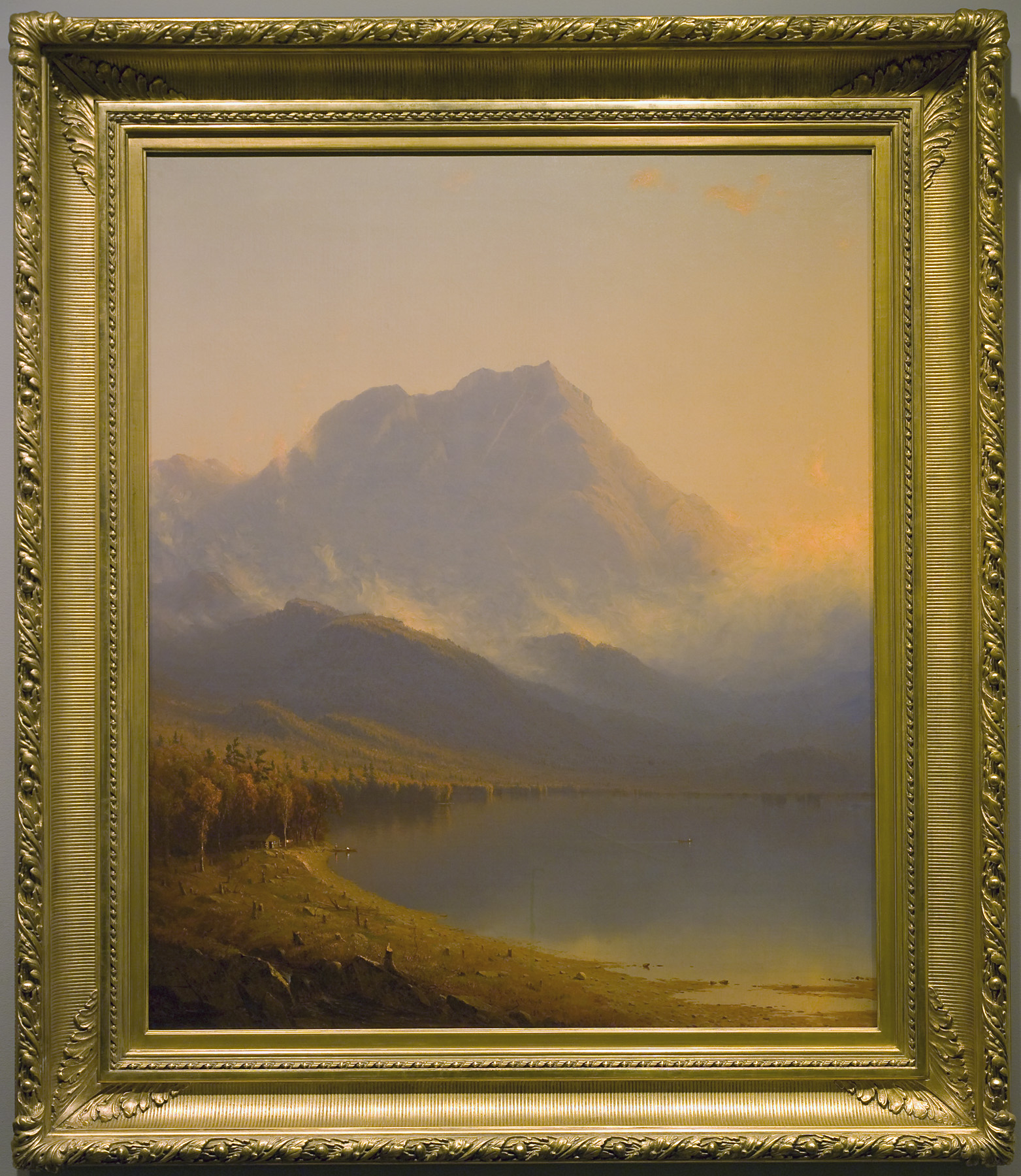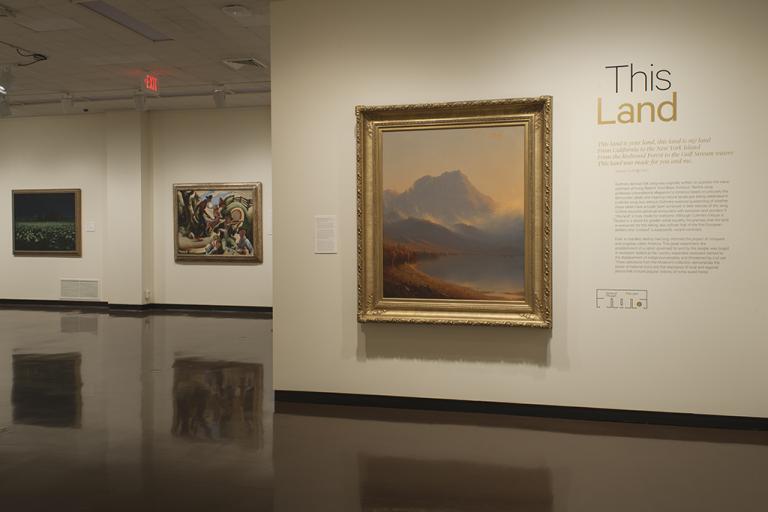Morning in the Adirondacks, Sanford Robinson Gifford
Artwork Overview
Canvas/Support (Height x Width x Depth): 50 1/4 x 42 1/4 in
Canvas/Support (Height x Width x Depth): 127.63 x 107.31 cm
Frame Dimensions (Height x Width x Depth): 64 1/2 x 56 x 6 3/4 in
If you wish to reproduce this image, please submit an image request
Images
Label texts
Morning in the Adirondacks culminates a series of paintings that resulted from visits Gifford made to the Adirondack wilderness of northern New York, beginning in the 1840s. As he depicts the vastness of the wilderness and the dramatic effects of mist and morning sunlight, Gifford also records the impact of the pioneer settlers who cleared the land and built homes there.
Sanford Robinson Gifford uses the dramatic effects of mist and morning sunlight to depict the vastness of the Adirondack Mountains in upstate New York. Painted just after the American Civil War (1861–1865), the artist also records the impact of the pioneer settlers who cleared the land and built homes there.
Sanford Robinson Gifford uses the dramatic effects of mist and morning sunlight to depict the vastness of the Adirondack Mountains in upstate New York. Painted just after the American Civil War (1861–1865), the artist also records the impact of the pioneer settlers who cleared the land and built homes there.
"In Europe people talk a great deal of the wilds of America, but the Americans themselves never think about them; they are insensible to the wonders of inanimate nature and they may be said not to perceive the mighty forests that surround them till they fall beneath the hatchet." — Alexis de Tocqueville, Democracy in America, 1840
Sanford Robinson Gifford and other Hudson River School painters challenged Alexis de Tocqueville’s belief that the wilderness held no fascination for Americans. Gifford delighted in painting the “glorious forest primeval” that filled the Adirondack Mountains of upstate New York. His treatment of the warm morning light reveals misty mountain peaks, abundant forests, and a quiet lake, but also illuminates a clearing around a small log cabin and the impact of this settlement upon the land.
"In Europe people talk a great deal of the wilds of America, but the Americans themselves never think about them; they are insensible to the wonders of inanimate nature and they may be said not to perceive the mighty forests that surround them till they fall beneath the hatchet." — Alexis de Tocqueville, Democracy in America, 1840
Sanford Robinson Gifford and other Hudson River School painters challenged Alexis de Tocqueville’s belief that the wilderness held no fascination for Americans. Gifford delighted in painting the “glorious forest primeval” that filled the Adirondack Mountains of upstate New York. His treatment of the warm morning light reveals misty mountain peaks, abundant forests, and a quiet lake, but also illuminates a clearing around a small log cabin and the impact of this settlement upon the land.
Morning in the Adirondacks displays a beautiful aura and appreciation of nature without explicit violence or conflict. The large size of this landscape allows viewers to place themselves within the scene and feel the stillness that it creates. It could seem to represent a time of peace, as it was painted just after the American Civil War, or question the relationship between man and nature. Envision yourself within this serene valley and breathe in the mountain air.
Morning in the Adirondacks displays a beautiful aura and appreciation of nature without explicit violence or conflict. The large size of this landscape allows viewers to place themselves within the scene and feel the stillness that it creates. It could seem to represent a time of peace, as it was painted just after the American Civil War, or question the relationship between man and nature. Envision yourself within this serene valley and breathe in the mountain air.
Thanks to students in MUSE 301 Ashley Aranda, Brett Doze, and Mika Schrader
Click on the audio tab above to listen to a student's interpretation of this object.
In Europe people talk a great deal of the wilds of America, but the Americans themselves never think about them; they are insensible to the wonders of inanimate nature and they may be said not to perceive the mighty forests that surround them till they fall beneath the hatchet. Their eyes are fixed upon another sight: the American people views its own march across these wilds, draining swamps, turning the course of rivers, peopling solitudes, and subduing nature.
—Alexis de Tocqueville, Democracy in America, 1840
Gifford and other Hudson River School painters challenged Tocqueville’s belief that the wilderness held no fascination for Americans, but the subjugation of nature persists as a theme in this composition. Gifford delighted in painting the “glorious forest primeval” that filled the Adirondack Mountains of upstate New York. His treatment of the warm morning light reveals misty mountain peaks, abundant forests, and a quiet lake, but also illuminates a clearing around a small log cabin and the impact of this settlement upon the land.
In Europe people talk a great deal of the wilds of America, but the Americans themselves never think about them; they are insensible to the wonders of inanimate nature and they may be said not to perceive the mighty forests that surround them till they fall beneath the hatchet. Their eyes are fixed upon another sight: the American people views its own march across these wilds, draining swamps, turning the course of rivers, peopling solitudes, and subduing nature.
—Alexis de Tocqueville, Democracy in America, 1840
Gifford and other Hudson River School painters challenged Tocqueville’s belief that the wilderness held no fascination for Americans, but the subjugation of nature persists as a theme in this composition. Gifford delighted in painting the “glorious forest primeval” that filled the Adirondack Mountains of upstate New York. His treatment of the warm morning light reveals misty mountain peaks, abundant forests, and a quiet lake, but also illuminates a clearing around a small log cabin and the impact of this settlement upon the land.
Morning in the Adirondacks culminates a series of paintings that resulted from visits Gifford made to the Adirondack wilderness of northern New York, beginning in the 1840s. As he depicts the vastness of the wilderness and the dramatic effects of mist and morning sunlight, Gifford also records the impact of the pioneer settlers who cleared the land and built homes there.
In Europe people talk a great deal of the wilds of America, but the Americans themselves never think about them; they are insensible to the wonders of inanimate nature and they may be said not to perceive the mighty forests that surround them till they fall beneath the hatchet. Their eyes are fixed upon another sight: the American people views its own march across these wilds, draining swamps, turning the course of rivers, peopling solitudes, and subduing nature.
-Alexis de Tocqueville, Democracy in America, 1840
Gifford and other Hudson River School painters challenged Tocqueville’s belief that the wilderness held no fascination for Americans, yet the subjugation of nature persists as a theme in this composition. Gifford delighted in painting the “glorious forest primeval” that filled the Adirondack Mountains of upstate New York. His treatment of the warm, morning light reveals misty mountain peaks, abundant forests, and a quiet lake but also illuminates a clearing around a small log cabin, alluding to the impact of this settlement upon the land.
In Europe people talk a great deal of the wilds of America, but the Americans themselves never think about them; they are insensible to the wonders of inanimate nature and they may be said not to perceive the mighty forests that surround them till they fall beneath the hatchet. Their eyes are fixed upon another sight: the American people views its own march across these wilds, draining swamps, turning the course of rivers, peopling solitudes, and subduing nature.
-Alexis de Tocqueville, Democracy in America, 1840
Gifford and other Hudson River School painters challenged Tocqueville’s belief that the wilderness held no fascination for Americans, yet the subjugation of nature persists as a theme in this composition. Gifford delighted in painting the “glorious forest primeval” that filled the Adirondack Mountains of upstate New York. His treatment of the warm, morning light reveals misty mountain peaks, abundant forests, and a quiet lake but also illuminates a clearing around a small log cabin, alluding to the impact of this settlement upon the land.
Exhibition Label:
"This Land," Mar-2014, Kate Meyer
In Europe people talk a great deal of the wilds of America, but the Americans themselves never think about them; they are insensible to the wonders of inanimate nature and they may be said not to perceive the mighty forests that surround them till they fall beneath the hatchet. Their eyes are fixed upon another sight: the American people views its own march across these wilds, draining swamps, turning the course of rivers, peopling solitudes, and subduing nature.
-Alexis de Tocqueville, Democracy in America, 1840
Gifford and other Hudson River School painters challenged Tocqueville’s belief that the wilderness held no fascination for Americans, yet the subjugation of nature persists as a theme in this composition. Gifford delighted in painting the “glorious forest primeval” that filled the Adirondack Mountains of upstate New York. His treatment of the warm, morning light reveals misty mountain peaks, abundant forests, and a quiet lake but also illuminates a clearing around a small log cabin, alluding to the impact of this settlement upon the land.
Archive Label:
In 1874 Gifford included Morning in the Adirondacks in a "List of some of my Chief Pictures, " having sold it in 1867 to an Englishman named Samuel Lord, one of the founders of Lord and Taylor department stores. Joseph Pearson purchased the painting in England in the 1950s and donated it to the University of Kansas to be used in the residence halls.
Morning in the Adirondacks culminates a series of painting that resulted from visits Gifford made to the Adirondack wilderness of northern New York, beginning in the 1840s. As he depicts the vastness of the wilderness and the dramatic effects of mist and morning sunlight, Gifford also records the impact of the pioneer settlers who cleared the land and built homes there.
In March of 2009, Morning in the Adirondacks was reframed in a virtuosic reproduction of an original American fluted-cove frame from the 1860s, just like frames used by Gifford and his Hudson River School artist colleagues.
The frame was made possible through the generosity of the Terra Foundation for American Art, Chicago, and by Eli Wilner & Company Period Frames and Mirrors, New York.
















